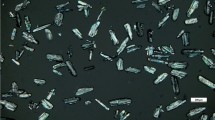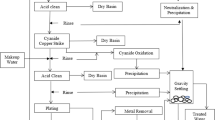Abstract
Mycotoxins occur widely in foodstuffs and cause a variety of mold-related health risks to humans and animals. Elucidation of the metabolic fate of mycotoxins and the growing number of newly discovered mycotoxins have enhanced the demand for fast and reliable simulation methods. The viability of electrochemistry coupled with mass spectrometry (EC/ESI-MS), Fenton-like oxidation, and UV irradiation for the simulation of oxidative phase I metabolism of the mycotoxins citrinin (CIT) and dihydroergocristine (DHEC) was investigated. The specific reaction products are compared with metabolites produced by human and rat liver microsomes in vitro. Depending on the applied potential between 0 and 2000 mV vs. Pd/H2 by using a flow-through cell, CIT and DHEC are oxidized to various products. Besides dehydrogenation and dealkylation reactions, several hydroxylated DHEC and CIT species are produced by EC and Fenton-like reaction, separated and analyzed by LC-MS/MS and ESI-HRMS. Compared to reaction products from performed microsomal incubations, several mono- and dihydroxylated DHEC species were found to be similar to the reaction products of EC, Fenton-like reaction, and UV-induced oxidation. Consequentially, nonmicrosomal efficient and economic simulation techniques can be useful in early-stage metabolic studies, even if one-to-one simulation is not always feasible.








Similar content being viewed by others
References
FAO. Worldwide regulations for mycotoxins in food and feed in 2003. Rome: FAO Food Nutr Pap; 2004. p. 81.
Marin S, Ramos AJ, Cano-Sancho G, Sanchis V. Mycotoxins: occurrence, toxicology, and exposure assessment. Food Chem Toxicol. 2013;60:218–37.
Petroczi A, Nepusz T, Taylor G, Naughton DP. Network analysis of the RASFF database: a mycotoxin perspective. World Mycotoxin J. 2011;4(3):329–38.
van Egmond HP, Schothorst RC, Jonker MA. Regulations relating to mycotoxins in food. Anal Bioanal Chem. 2007;389(1):147–57.
Meunier B, de Visser SP, Shaik S. Mechanism of oxidation reactions catalyzed by cytochrome P450 enzymes. Chem Rev. 2004;104(9):3947–80.
Guengerich FP. Common and uncommon cytochrome P450 reactions related to metabolism and chemical toxicity. Chem Res Toxicol. 2001;14(6):611–50.
Pfeiffer E, Schebb NH, Podlech J, Metzler M. Novel oxidative in vitro metabolites of the mycotoxins alternariol and alternariol methyl ether. Mol Nutr Food Res. 2007;51(3):307–16.
Lohmann W, Karst U. Biomimetic modeling of oxidative drug metabolism. Anal Bioanal Chem. 2008;391(1):79–96.
van Leeuwen SM, Blankert B, Kauffmann JM, Karst U. Prediction of clozapine metabolism by on-line electrochemistry/liquid chromatography/mass spectrometry. Anal Bioanal Chem. 2005;382(3):742–50.
Wang S. A comparative study of Fenton and Fenton-like reaction kinetics in decolourisation of wastewater. Dyes Pigments. 2008;76(3):714–20.
Dong QF, Manns DC, Feng GP, Yue TL, Churey JJ, Worobo RW. Reduction of Patulin in apple cider by UV radiation. J Food Protect. 2010;73(1):69–74.
Espejo F. Effect of photo-Fenton reaction on physicochemical parameters in white wine and its influence on ochratoxin A contents using response surface methodology. Eur Food Res Technol. 2016;242(1):91–106.
Koppen R, Riedel J, Proske M, Drzymala S, Rasenko T, Durmaz V, et al. Photochemical trans-/cis-isomerization and quantitation of zearalenone in edible oils. J Agr Food Chem. 2012;60(47):11733–40.
Wadworth AN, Chrisp P. Co-dergocrine mesylate—a review of its pharmacodynamics and pharmacokinetic properties and therapeutic use in age-related cognitive decline. Drug Aging. 1992;2(3):153–73.
Flieger M, Wurst M, Shelby R. Ergot alkaloids—sources, structures and analytical methods. Folia Microbiol. 1997;42(1):3–29.
Frisvad JC, Thrane U, Samson RA, Pitt JI. Important mycotoxins and the fungi which produce them. Adv Exp Med Biol. 2006;571:3–31.
Böhm J, De Saeger S, Edler L, Fink-Gremmels J, Mantle P, Peraica M, et al. Scientific opinion on the risks for public and animal health related to the presence of citrinin in food and feed. EFSA. 2012;10(3):1–82.
Monch B, Kraus W, Koppen R, Emmerling F. The different conformations and crystal structures of dihydroergocristine. J Mol Struct. 2016;1105:389–95.
Simon H, Hoffmann G, Hubner F, Humpf HU, Karst U. Electrochemical simulation of metabolic reactions of the secondary fungal metabolites alternariol and alternariol methyl ether. Anal Bioanal Chem. 2016;408(10):2471–83.
Bazin I, Faucet-Marquis V, Monje MC, El Khoury M, Marty JL, Pfohl-Leszkowicz A. Impact of pH on the stability and the cross-reactivity of ochratoxin A and citrinin. Toxins. 2013;5(12):2324–40.
Dunn BB, Stack ME, Park DL, Joshi A, Friedman L, King RL. Isolation and identification of dihydrocitrinone, a urinary metabolite of citrinin in rats. J Toxicol Environ Health. 1983;12(2–3):283–9.
Ali N, Blaszkewicz M, Degen GH. Occurrence of the mycotoxin citrinin and its metabolite dihydrocitrinone in urines of German adults. Arch Toxicol. 2015;89(4):573–8.
Clark BR, Capon RJ, Lacey E, Tennant S, Gill JH. Citrinin revisited: from monomers to dimers and beyond. Org Biomol Chem. 2006;4(8):1520–8.
Blaszkewicz M, Munoz K, Degen GH. Methods for analysis of citrinin in human blood and urine. Arch Toxicol. 2013;87(6):1087–94.
Bicalho B, Giolo JM, Lilla S, De Nucci G. Identification and human pharmacokinetics of dihydroergotoxine metabolites in man: preliminary results. Biopharm Drug Dispos. 2008;29(1):17–28.
Peyronneau MA, Delaforge M, Riviere R, Renaud JP, Mansuy D. High-affinity of ergopeptides for cytochromes P450 3A—importance of their peptide moiety for P450 recognition and hydroxylation of bromocriptine. Eur J Biochem. 1994;223(3):947–56.
Jurva U, Wikstrom HV, Weidolf L, Bruins AP. Comparison between electrochemistry/mass spectrometry and cytochrome P450 catalyzed oxidation reactions. Rapid Commun Mass Sp. 2003;17(8):800–10.
Acknowledgements
The authors would like to thank Mr. Boris Neumann (Proteome Factory AG, Berlin, Germany) for the HRMS analyses.
Author information
Authors and Affiliations
Corresponding author
Ethics declarations
Conflict of interest
The authors declare that they have no conflict of interest.
Rights and permissions
About this article
Cite this article
Keller, J., Haase, H. & Koch, M. Electrochemical simulation of biotransformation reactions of citrinin and dihydroergocristine compared to UV irradiation and Fenton-like reaction. Anal Bioanal Chem 409, 4037–4045 (2017). https://doi.org/10.1007/s00216-017-0350-6
Received:
Revised:
Accepted:
Published:
Issue Date:
DOI: https://doi.org/10.1007/s00216-017-0350-6




